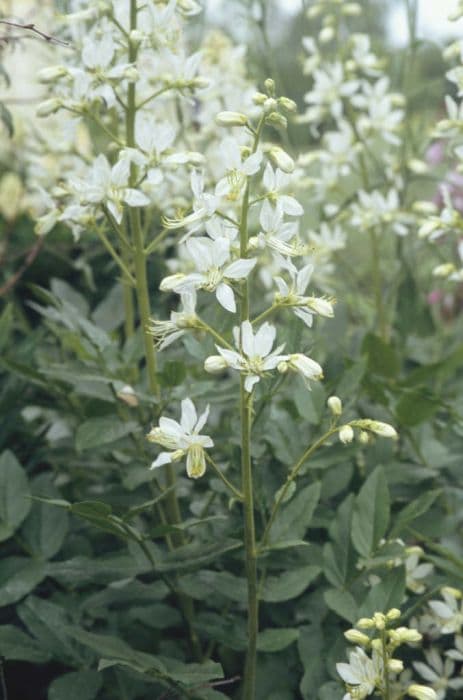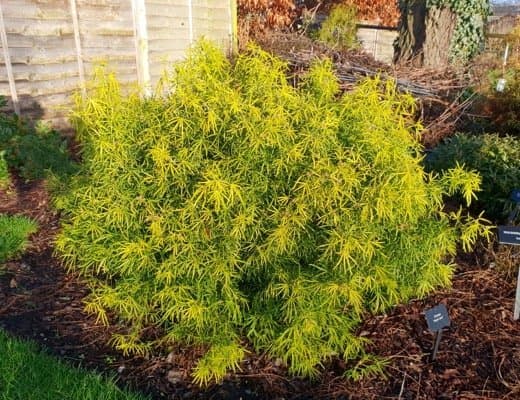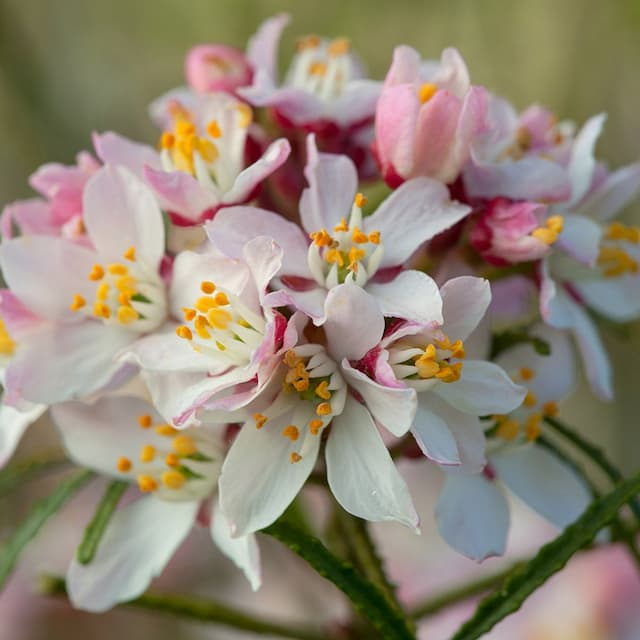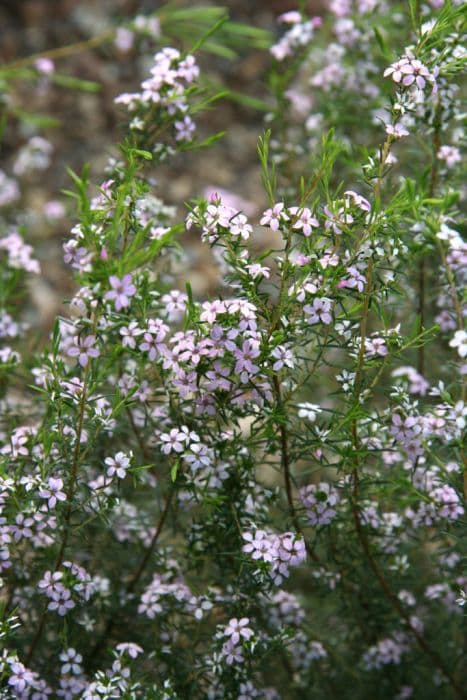Burning bush Dictamnus albus

ABOUT
The plant commonly known as the burning bush is a perennial herb that stands out for its attractive and distinctive appearance. It boasts a clump-like form with branches that appear woody at the base. The leaves of the burning bush are pinnately compound, meaning they have multiple leaflets arranged along a central stem, and these are usually glossy, exuding a pleasant aroma when crushed. During its blooming period, which occurs in late spring to early summer, the burning bush produces an impressive display of flowers. The flowers are arranged in showy pyramidal clusters at the ends of the branches. Each flower has five petals, and they are colored in various shades of white to pink, often accentuated with a lovely purple veining, giving the plant an enchanting look. The flowers are noted for their delicate, yet lively, lemon-like fragrance, which adds to the sensory delight of this plant. Another characteristic feature of the burning bush is its seed pods, which add further visual interest after the flowering season. The seed pods initially appear green and then ripen to a woody brown, each containing several seeds that are ejected forcefully when ripe, aiding in the plant's dispersal. An unusual aspect of the burning bush is its ability to produce volatile oils that can be ignited on a calm, hot day, giving the impression that the plant is on fire without being consumed, which is the origin of its common name. However, this feature should be approached with caution due to the risk of fire and the potential for skin irritation.
About this plant
 Names
NamesFamily
Rutaceae.
Synonyms
Burning Bush, Gas Plant, Dittany, White Dittany, Fraxinella.
Common names
Dictamnus albus var. albus, Dictamnus albus var. purpureus, Dictamnus fraxinella Pers., Dictamnus hispanicus Webb, Dictamnus suffruticosus Salisb.
 Toxicity
ToxicityTo humans
The burning bush, Dictamnus albus, contains furoquinoline alkaloids which can be toxic if ingested. Skin contact with its sap under sunlight can also cause phytophotodermatitis, a light-sensitized skin reaction. Symptoms of ingestion can include nausea, vomiting, abdominal pain, and diarrhea. In severe cases, it can lead to more serious symptoms such as convulsions or heart and respiratory difficulties. It is advised to avoid ingesting any part of the burning bush plant due to its toxic properties.
To pets
The burning bush is also toxic to pets, including dogs and cats, if ingested. Its toxic compounds can cause gastrointestinal upset including vomiting and diarrhea. In more severe cases, it may lead to more serious symptoms which can include tremors, seizures, or respiratory difficulties. It is important to prevent pets from ingesting any part of the burning bush plant because of its potential for causing toxicity.
 Characteristics
CharacteristicsLife cycle
Perennials
Foliage type
Deciduous
Color of leaves
Green
Flower color
White
Height
2-4 feet (0.6-1.2 meters)
Spread
2-3 feet (0.6-0.9 meters)
Plant type
Herb
Hardiness zones
3-8
Native area
Europe Asia
Benefits
 General Benefits
General Benefits- Ornamental Value: Dictamnus albus, commonly known as Burning Bush, is often used in gardens for its beautiful flowers and unique structure.
- Fragrance: The plant emits a strong lemon-like fragrance, particularly in the evening, enhancing the sensory experience of a garden.
- Pollinator Attraction: The flowers of the Burning Bush attract a variety of pollinators, including bees and butterflies, which are beneficial for the ecosystem.
- Drought Tolerance: Once established, Burning Bush is known for its ability to withstand periods of drought, making it suitable for xeriscaping.
- Low Maintenance: It generally requires minimal care beyond the initial planting and establishment phase, which is ideal for gardeners looking for low-maintenance plants.
- Deer Resistance: The plant is considered to be deer-resistant, which is advantageous in areas where deer predation on garden plants is a problem.
 Medical Properties
Medical Properties- Anti-inflammatory: Dictamnus albus has been traditionally used to reduce inflammation.
- Antimicrobial: Components of the plant have shown to possess antimicrobial properties, potentially useful in treating infections.
- Antifungal: The plant has also been used in traditional medicine to treat fungal infections.
- Sedative: There are historical references to the plant's use as a sedative to calm nerves.
- Gastroprotective: It has been used in traditional medicine to help with gastrointestinal issues, possibly due to its anti-inflammatory effects.
 Air-purifying Qualities
Air-purifying QualitiesThis plant is not specifically known for air purifying qualities.
 Other Uses
Other Uses- Photographic Plant Specimen: Due to its unique appearance, Dictamnus albus is used by photographers as a subject for botanical photography and art.
- Insect Repellant Garden Plant: The essential oils contained within Dictamnus albus can naturally repel certain insects, making it an assisting plant in gardens to protect other plants.
- Natural Dye Source: The roots of Dictamnus albus can be used to produce a natural dye for coloring fabrics or crafts.
- Landscape Design: With its striking white or pink flowers, it is often planted for ornamental purposes in landscape design to create visually appealing gardens.
- Combustible Material Demonstrations: The volatile oils exuded by the plant can be ignited on a warm day, offering a demonstration of natural flammability for educational purposes.
- Flash Photography Experiments: Due to its flammable emissions, it has been used in controlled experiments to demonstrate the effects of flammability on flash photography.
- Religious Ceremonies: In some cultures, the plant is used symbolically in religious ceremonies due to its "burning bush" appearance when its oils are ignited.
- Perfume Ingredient: The oils of Dictamnus albus are sometimes incorporated into perfumes for its unique aromatic properties.
- Educational Tool in Botany: Used as an educational specimen to teach students about unique plant adaptations, such as its oil emissions and resistance to certain pests.
- Aromatherapy: The scent emitted by the flower and leaves is occasionally used in aromatherapy practices for relaxation and stress relief, though it should be used with caution due to possible skin irritation.
Interesting Facts
 Feng Shui
Feng ShuiThe Burning Bush is not used in Feng Shui practice.
 Zodiac Sign Compitability
Zodiac Sign CompitabilityThe Burning Bush is not used in astrology practice.
 Plant Symbolism
Plant Symbolism- Purity: Dictamnus albus, commonly known as Gas Plant, has white blossoms that are often associated with the concept of purity and innocence.
- Enlightenment: The Gas Plant is capable of producing a flammable substance, causing its flowers to briefly ignite when lit. This characteristic may symbolize enlightenment and the idea of an epiphany or sudden clarity.
- Protection: Historical uses of the Gas Plant include using its roots and leaves for medicinal purposes. Its association with healing has led to it being a symbol of protection and safety.
- Perseverance: The Gas Plant can thrive in tough soil conditions, symbolizing perseverance and the ability to endure challenging environments.
- Mystery: Due to the Gas Plant's unique ability to produce flammable oils, it holds an air of mystery and the unknown, symbolizing things that are beyond the immediate comprehension.
 Water
WaterThe gas plant (Dictamnus albus) should be watered regularly during its first growing season to establish a deep, extensive root system. Once established, it is quite drought-tolerant and requires less frequent watering. Depending on temperature and soil conditions, watering once a week with about 1 to 1.5 gallons of water should be sufficient. During hot, dry periods, increase the frequency to every 3 to 5 days, ensuring the soil is moist but not waterlogged. Reduce watering in the fall as the plant prepares for dormancy.
 Light
LightThe gas plant thrives best in full sun where it can receive at least six hours of direct sunlight daily. The ideal spot would be an open area in the garden with southern or western exposure to ensure it gets ample light. However, it can tolerate light shade, especially in the afternoon during the hottest part of the day.
 Temperature
TemperatureThe gas plant prefers temperate climates with temperatures ranging between 60°F and 75°F for ideal growth. It can withstand minimum temperatures down to about -30°F and maximum temperatures up to around 90°F. Avoid placing the gas plant in locations where temperatures fluctuate dramatically as consistent conditions are more conducive to its health.
 Pruning
PruningPruning the gas plant is generally done to remove dead flowers and maintain its neat appearance. It is best to prune immediately after flowering, which usually occurs in late spring or early summer. Cutting back the spent flower stalks will often encourage a second bloom. Pruning can also involve removing any damaged or diseased stems to maintain plant health.
 Cleaning
CleaningAs needed
 Soil
SoilBurning Bush prefers well-draining soil with a slightly acidic to neutral pH of about 6.0 to 7.0. A good mix would be a combination of loamy soil, peat moss, and some sand to ensure adequate drainage and aeration.
 Repotting
RepottingBurning Bush is a slow-growing plant and does not need frequent repotting. It typically requires repotting every 3 to 4 years, or when the root system outgrows the current container.
 Humidity & Misting
Humidity & MistingThe Burning Bush plant tolerates average humidity levels but does well with a bit more humidity. Aim for humidity levels around 40-50% for optimal growth.
 Suitable locations
Suitable locationsIndoor
Place in bright, indirect light and keep soil lightly moist.
Outdoor
Plant in well-draining soil, full sun to partial shade.
Hardiness zone
4-8 USDA
 Life cycle
Life cycleDictamnus albus, commonly known as the burning bush, begins its life cycle with seed germination which typically occurs in early spring, though this plant often has a low germination rate and may require stratification to break dormancy. Seedlings develop into rosettes, with a root system that gradually establishes itself in the first growing season. As a perennial, the plant will then enter a vegetative state, growing its foliage which is made up of pinnate leaves with leaflets that are lance-shaped and often have a lemony fragrance. Following the vegetative stage, around late spring to early summer, the burning bush produces its distinctive flowers: showy, five-petaled, white or pink blossoms that are grouped in loose pyramidal clusters. After pollination, typically by bees and other insects, the flowers develop into capsule-like fruit that contain the seeds which, upon maturation, are dispersed to begin a new cycle. The plant then enters a period of dormancy during the winter months, where above ground parts die back and growth ceases until the following spring.
 Propogation
PropogationPropogation time
Spring to Summer
The gas plant, Dictamnus albus, is commonly propagated by seed. The best time to sow seeds is in the fall, directly outdoors, as they require a cold period to break dormancy. Alternatively, if planting in the spring, the seeds may first need to be stratified, which means exposing them to a cold treatment to simulate winter, usually for a period of 6-8 weeks at about 40 degrees Fahrenheit (4.4 degrees Celsius). Once sown, it is important to provide consistent moisture until germination, which can be slow and irregular, often taking several weeks to months. Seedlings require careful nurturing, and it may take several years for them to flower. This slow growth and lengthy germination period make the seed propagation method popular for those who appreciate its simplicity and do not need immediate results.









